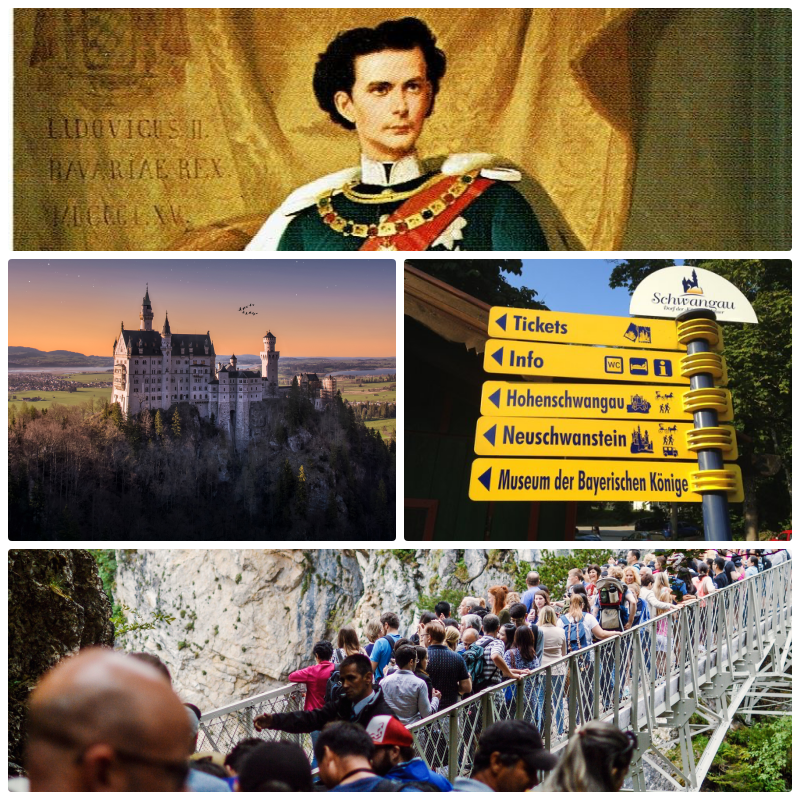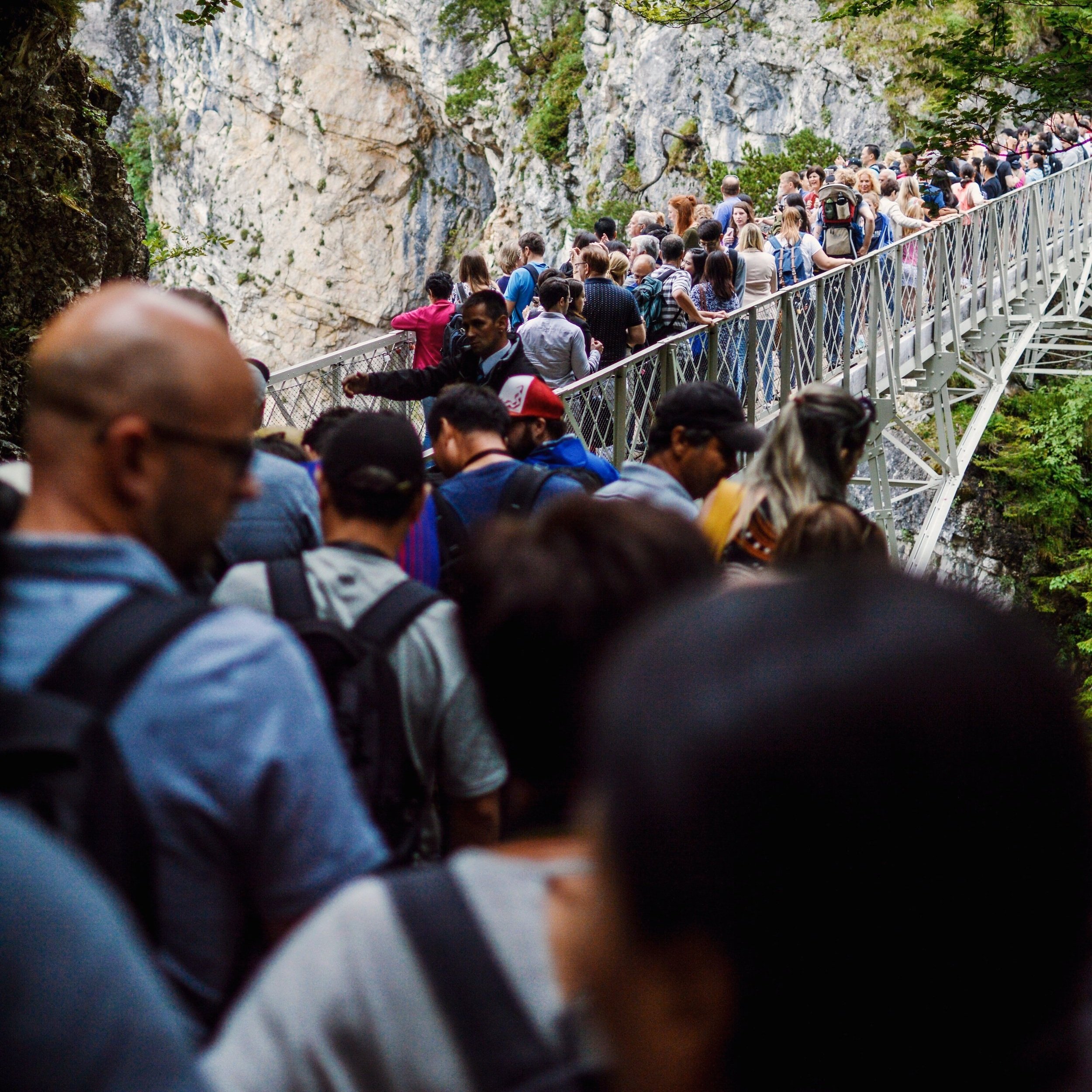All Roads Lead to Neuschwanstein
Whenever we plan our summer holidays, my wife will loudly declare “Let’s go somewhere with a beach”. A love of the coast is to be expected, given she’s lived most of her life in the landlocked Bavaria, and for her family, it wasn’t a real summer holiday unless they were cleaning sand out of everything they owned for months afterwards. Sadly for my wife, I don’t share the same affection for the sea, living on an island for a couple of decades will do that. Familiarity breeds contempt, it seems, even with holiday destinations, and coming from the north east of England, beach holidays were the norm. With the coast only a few stops on the Metro line from where we lived in the city centre, day trips to Tynemouth or Cullercoats to enjoy the bracing wind and refreshing temperatures of the North Sea were not only easy, but far more affordable than any holiday abroad.
The fact that my family in the UK lives so close to the beach does create a dilemma when deciding where to go for a summer break. I’ve argued that visiting Newcastle upon Tyne is a beach holiday too, with the added bonus of a chance to see the British family. This makes heading north rather than south a far more convenient trip, or at least that’s my argument, but my wife doesn’t agree, despite the obvious efficiency of my plan. Apparently eating fish and chips in the rain while overlooking the North Sea is not the same as sunning ourselves on the Italian Riviera. My wife may have a point, but with a limited window for summer holidays, it can be difficult to find the right balance between family commitments and the desire to get away from it all. Holidays to Britain are great, but they aren’t the same as normal holidays, and it’s certainly far more stressful than the alternatives. In my experience they’re far busier, especially if your family lives in different towns or cities. Thankfully there’s a compromise to be made, a simple way to break the holiday deadlock is to invite our British family to Germany.
There are several advantages to this solution, the most obvious being that we don’t have to do any of the travel leg work. It’s not that we object to hopping on and off planes or waiting in airport terminals for delayed flights, but since having our son and daughter, we’ve become a lot more cautious about travelling long distances. Taking a three year old and a 10 week old baby on holiday anywhere is a gamble - we’re basically travelling with time-bombs that at any point could explode in our faces. The baby isn’t too much of a hassle, but our daughter is a different story. You can’t reason with a three-year-old, they’re driven by pure impulse. We could bribe her, but aside from dolls, the only thing she treats with any level of seriousness is chocolate. Filling our daughter with sugar in order to placate her worst tendencies does feel like trying to disarm a bomb by hitting it really hard with another, much larger bomb.
The only disadvantage of having family come visit is planning what to do with them when they get here. Initially this was easy; most of my family had never been to Germany, so taking them for a walk to the local bakery was an excursion in itself. However, after a decade of visits, wandering over to buy some cakes is now so normal they don’t even take photos anymore. My family also tends to do more research before arriving than they used to and they now know more about what to expect when they travel to see us. I spend most of their visits ferrying them to random lakes they’ve discovered online, or trying to find the best supplier of Pfefferbießer, so people can take a meaty souvenir back home. Sometimes though, it’s worth reminding the family that there are some truly amazing things to see in Germany. In those moments, when we really want to impress, we pack everyone into the car and head to Neuschwanstein.
Neuschwanstein is one of the most iconic sites in the whole of Germany. Situated among the extraordinary scenery of the Bayerische Voralpen, it looks like something ripped directly from a Grimms' Fairy Tale. It may appear much older, but the castle was actually built in the middle of the 19th century by the eccentric monarch King Ludwig II of Bavaria. In charge during a turbulent period in German history, Ludwig spent little of his time on politics, and instead used his wealth to build a series of elaborate castles, culminating in the fantastic Neuschwanstein. The castle includes an indoor cave, taps that flow with ice cold Alpine water and a throne room (minus the throne). Ludwig was inspired by the works of Richard Wagner, and drew heavily from German history and folklore. The theatricality of Schloss Neuschwanstein was cemented by Ludwig’s appointment of Christian Jank, a stage designer, who created the initial sketches of the castle which were converted into architectural plans. Sadly, Ludwig’s obsession with Neuschwanstein and his many other expensive castle building projects were ultimately his undoing. After accumulating 14 million Marks worth of personal debt, his projects were considered by his ministers to be negatively impacting the Bavarian economy, despite Ludwig never having spent public money. He was deposed after accusations of insanity and a few days later was found drowned, alongside the only witness, his physician.
Ludwig’s castle building, coupled with his mysterious death, have created a booming tourist economy in the south of Bavaria. Once considered the follies of a mentally unstable king, they are now incredibly popular, and draw thousands of visitors from around the world who want to see a real fairytale castle, or hear the theories that swirl around the monarch's death. Even if the accusations of appropriating state funds had been true, Ludwig’s legacy has paid that debt in full, hundreds of times over. At Neuschwanstein, visitors can make their way up the mountain side, either on foot, by bus or in a horse drawn cart. Arriving at the gates, tourists can enjoy a very short, but interesting guided tour through the finished rooms of the castle. Although Ludwig spent a lot of money, the castle was never actually finished and there remain many areas that are shadows of what was originally intended.
When I tell German friends that I’m planning another visit, they’ll quietly admit that they’ve never actually been, let alone multiple times. In fact, very few Germans I know have ever bothered to make the journey. In fairness to them, Neuschwanstein has the reputation as a tourist trap, which is made abundantly clear the moment someone attempts to sell you a range of overpriced dish towels featuring Bavarian mountain scenes or a €1000 cuckoo clock. It can be tough navigating a path through safari vest-wearing geriatrics and groups of people inexplicably photographing everything using their iPads. If it wasn’t for my need to keep various family members entertained, I would probably have settled with just a single visit.
Yet there’s something special about the journey to see the mad king’s fairy tale castle. Travelling there, especially in the height of summer, it’s hard not to appreciate the beauty of the south of Germany. The mountains, sitting next to seemingly endless green meadows, crowned with clear blue sky, it’s easy to understand why the area is such a draw for tourists. The combination of all three, and the addition of a real life fantasy castle, is a truly magical sight, one that should be experienced at least once, if not several times. I may have lost count of how often I’ve been to Neuschwanstein, but it never fails to take my breath away.
Proofreader: @ScandiTina
Image Credit
Photo by Ruben Hanssen on Unsplash
Photo by Massimiliano Morosinotto on Unsplash
Photo by Victor Malyushev on Unsplash
Photo by Nick Randle on Unsplash
Photo by Johannes Plenio on Unsplash









